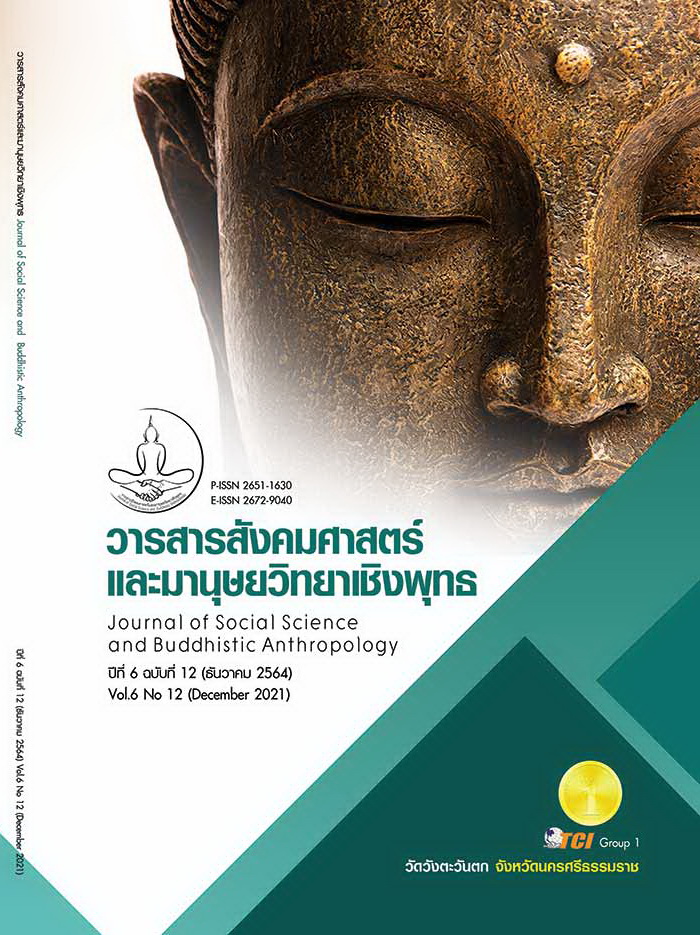THE DEVELOPMENT OF SUPERVISORY MODEL TO CREATE TEACHER PROFESSIONAL LEARNING COMMUNITY IN THE NORTH EASTERN AREA
Keywords:
Model, Supervision, Teacher Professional Learning CommunityAbstract
This research article aimed to develop supervisory model to create teacher professional learning community in the north eastern area. The sample of the study was 760 consisted of 380 school administrators and 380 teachers, they were selected by using the table of Krejcie and Morgan. The instruments used for data collection were questionnaire, structured interview, and evaluation form. The data were analyzed by using percentage, mean and standard deviation The results of the study revealed that 1. The results of the study related to current situations and desirable situations of the supervision to create teacher professional learning community in schools of the north eastern area pointed out that overall of the current situations rated in more level (mean 3.60) and the overall of the desirable situations rated in the most level (mean 4.70) when considered into each aspect found that all of the elements rated in the most level. 2. The results of the development a supervisory model shown that there were 4 elements of the supervisory model comprised of 1) making relationship, 2) planning, 3) performance and 4) evaluation for enhancing. The processes of teacher professional learning community consisted of 1) co-vision, 2) team working, 3) leadership, 4) learning for professional development, 5) friendship community and 6) structure of community supports. The appropriateness, the possibility and the benefits of the supervisory model was rated and shown in the most level. 3. The results of implementing the supervisory model to create teacher professional learning community revealed that all participants gained more understanding of supervision, learning management and passed the criteria of the evaluation. Moreover, participants satisfied with the supervisory model to create teacher professional learning community rated in the most level.
References
ในเขตพื้นที่ภาคตะวันออกเฉียงเหนือต่อการพัฒนาประเทศ. ขอนแก่น: แอนนาเซต.
ไชยยศ ไพวิทยศิริธรรม และยุวรี ผลพันธิน. (2559). แนวทางการพัฒนาสมรรถนะด้านการวิจัยสำหรับ
นักศึกษาครู: การประเมินความต้องการจำเป็นแบบสมบูรณ์. นครปฐม: คณะศึกษาศาสตร์
มหาวิทยาลัยศิลปากร.
ธิดา ขันดาวงศ์ และคณะ. (2557). การพัฒนารูปแบบการนิเทศแนวใหม่เพื่อพัฒนาคุณภาพครูปฐมวัย
สังกัดสำนักงานคณะกรรมการการศึกษาขั้นพื้นฐาน. วารสารราชพฤกษ์, 12(1). 45-53.
ภัณฑิรา สุปการ. (2558). รูปแบบการบริหารการจัดการนิเทศการศึกษา สำหรับศตวรรษที่ 21. ใน
วิทยานิพนธ์ปริญญาการศึกษาดุษฎีบัณฑิต สาขาวิชาการบริหารการศึกษา บัณฑิตวิทยาลัย.
มหาวิทยาลัยศิลปากร.
มณฑาทิพย์ ขันแก้ว. (2554). รายงานการวิจัยกระบวนเสริมสร้างพฤติกรรมความรับผิดชอบต่อองค์กร
ตามหลักพุทธจิตวิทยาของบุคลากรมหาวิทยาลัยมหาจุฬาลงกรณราชวิทยาลัยใน
ภาคตะวันออกเฉียงเหนือ. เชียงใหม่: มหาวิทยาลัยเชียงใหม่.
เรวณี ชัยเชาวรัตน์. (2556). แนวคิดชุมชนการเรียนรู้ทางวิชาชีพเพื่อการพัฒนาวิชาชีพครู (PLC for Teacher Professional Development). วารสารครุศาสตร์มหาวิทยาลัยราชภัฏสุรินทร์, 10(1). 34-46.
วรลักษณ์ ชูกำเนิด. (2557). รูปแบบชุมชนการเรียนรู้ทางวิชาชีพครูสู่การเรียนรู้ในศตวรรษที่ 21 บริบท โรงเรียนในประเทศไทย. ใน วิทยานิพนธ์ปริญญาศึกษาศาสตรดุษฎีบัณฑิต สาขาวิชาการบริหารการศึกษา บัณฑิตวิทยาลัย. มหาวิทยาลัยสงขลานครินทร์.
วัชรา เล่าเรียนดี. (2552). รูปแบบและกลยุทธ์การจัดการเรียนรู้เพื่อพัฒนาทักษะการคิด. (พิมพ์ครั้งที่ 4). นครปฐม: คณะศึกษาศาสตร์ มหาวิทยาลัยศิลปากร.
วัชรา เล่าเรียนดี. (2556). ศาสตร์การนิเทศการสอนและการโค้ชการพัฒนาวิชาชีพ: ทฤษฎี กลยุทธ์สู่การปฏิบัติ. (พิมพ์ครั้งที่ 12). นครปฐม: คณะศึกษาศาสตร์ มหาวิทยาลัยศิลปากร.
วิจารณ์ พานิช. (2555). การเรียนรู้เพื่อศิษย์ในศตวรรษที่ 21. กรุงเทพมหานคร: มูลนิธิสดศรี-สฤษดิ์วงศ์.
วีระพงษ์ เทียมวงษ์. (2563). การพัฒนารูปแบบการจัดการความรู้ด้านการนิเทศติดตามและประเมินผลการจัดการศึกษาของสำนักงานเขตพื้นที่การศึกษาประถมศึกษา. ใน วิทยานิพนธ์ปริญญาการศึกษาดุษฎีบัณฑิต สาขาวิชาการนิเทศการศึกษา คณะศึกษาศาสตร์. มหาวิทยาลัยมหาสารคาม.
ศักดิ์ชัย ภู่เจริญ. (2557). คุณลักษณะผู้นำของผู้บริหารโรงเรียนด้านการบริหารจัดการ. เรียกใช้เมื่อ
29 พฤษภาคม 2560 จาก http://www.kruinter.com.
ศูนย์พัฒนาการนิเทศและเร่งรัดคุณภาพการศึกษาขั้นพื้นฐาน. (2555). รายงานการศึกษา สภาพการนิเทศ ปัญหา ความต้องการ และรูปแบบการนิเทศที่เอื้อต่อการยกระดับคุณภาพการศึกษา สำนักงานคณะกรรมการสถานศึกษาขั้นพื้นฐาน. กรุงเทพมหานคร: เจ.เอ็น.ที.
สำนักงานเลขาธิการสภาการศึกษา. (2558). รายงานผลการศึกษา: สถานภาพการผลิตและพัฒนาครูใน
ประเทศไทย. เรียกใช้เมื่อ 29 มีนาคม 2561 จาก http://backoffice.onec.go.th /uploads/Book/1442-file.pdf).
อธิศ ไชยคิรินทร์. (2562). รูปแบบการนิเทศภายในโดยใช้กระบวนการชุมชนการเรียนรู้ทางวิชาชีพสําหรับโรงเรียนมัธยมศึกษา. ใน วิทยานิพนธ์ปริญญาการศึกษาดุษฎีบัณฑิต สาขาวิชาการนิเทศการศึกษา คณะศึกษาศาสตร์. มหาวิทยาลัยมหาสารคาม.
อนงค์นาถ เคนโพธิ์. (2562). การพัฒนาชุดฝึกลีลามือเพื่อส่งเสริมความพร้อมด้านการเขียนของเด็กปฐมวัย. ใน
วิทยานิพนธ์ปริญญาการศึกษาดุษฎีบัณฑิต สาขาวิชาการนิเทศการศึกษา คณะศึกษาศาสตร์.
มหาวิทยาลัยมหาสารคาม.
Battersby, S. (2015). The Culture of Professional Learning Communities and Connections to
Improve Teacher Efficacy and Support Student Learning. Arts education policy
review, 116(3). 22–29.
Blacklock, P. J. (2009). The Five Dimensions of Professional Learning Communities in
Improving Exemplary Texas Elementary Schools: A Descriptive Study. Retrieved
February 18, 2015, from http://digital.library.unt.edu/ark:/67531/metadc12084/.
Caine, G., and Caine, R.N. (2010). Strengthening and Enriching Your Professional Learning
Community : The Art of Learning Together. Alexandria: ASCD.
DuFour, R., Eakey, R. and Many, T. (2006). Learning by Doing. A Handbook for Professional Learning Communities at Work. Bloomington, IN: Solution Tree Press.
DuFour, R., and Eakey, R. (2008). Revisiting Professional Learning Communities at
Work. Bloomington, IN: Solution Tree Press.
Glickman, C.D. and others. (2010). Supervision and Instructional Leadership :
A Developmental Approach. (8th ed). Boston: Allyn and Bacon.
Joyce, B. and Calhoun, E. (2010). Model of Professional Development : A Celebration of
Educators. California: Corwin.
Krejcie, R. V. & Morgan, D. W. (1970). Determining Sample Size for Research Activities.
Educational and Psychological Measurement, 30(3). 607- 610.
Office of the Education Council. (2017). National Education Plan 2017-2036. Bangkok:
Prigwan Grafig.
Phrapalad Somchai Payogo (Damnoen), & Phumphongkhochasorn, P. (2020). The
Development of the Innovative Model of School Administration in the Secondary
Education Area Office 18. Solid State Technology, 63(2s). 2058-2065.
Thomus, W. and Smith, A. (2009). Coaching Practical Ways to Improve Performance in Education Solutions. (2nd ed). Glasgow: Bell & Bain.








